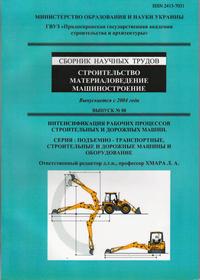Special continious action earthmoving machines, as a recovery tool of major pipeline reliable operation
Keywords:
Pipeline, soil, machine, rate, contradiction, lifting.Abstract
Summary. Raising of problem. The current state of pipeline highways in Ukraine and in other countries, calls for the urgent implementation of overhaul. Existing hardware for performance of major repairs, especially machines for excavation and their using technology does not allow to carry out major repairs of the pipelines with necessary rates. Purpose. Solution of the problem can be reached by the new continuous action earthmoving machines creating. The using of them allows to increase the rates of earthworks in process of major pipeline repair, to provide the pipeline reapairing by the fast non-lifting method. It will increase the safety of repairing. Conclusions. Created machines as a result of complex research provide the performance of earthworks 80-120 run. m/h depending on the diameter of the pipeline and ground conditions. It becomes possible to safe (distance from the pipe 200±50 mm) and synchronous movement with a predetermined speed of technological columns machines along the pipeline while its repairing Contradictions between the rate of excavation and repair work on the pipe are removed. The using of the special continuous action earthmoving machines eliminates the need for additional support or lifting tube in the process of its repair .
References
Balovnev V. I. Intensifikaciya zemlyanyx rabot v dorozhnom stroitel'stve [Intensification of earthworks in road construction] / V. I. Balovnev, L. A. Khmara. Moscow.: Transport, 1983. – 183 p. (in Russian).
Vasilenko S. K. Texnologiya i kompleks texnicheskix sredstv dlya kapital'nogo remonta magistral'nyx nefteprovodov bez pod''ema truby [Technology and complex of technical means for the overhaul of main oil pipelines without lifting tube] / S. K. Vasilenko, A. V. Bikov, V. D. Musiiko // Truboprovodnyj transport nefti -Oil pipeline transport. – Moscow.: "Transneft", 1994. – №2. – P. 25–28. (in Russian).
VBN V.3.1-320.20077720.01:2001. Technology of the major overhaul of main pipelines with a diameter of 530 -1220 mm with the changing of the isolation without lifting the pipe by using the high-productivity machines (in Russian).
Garbuzov Z. E., Donskoi V. M. Ekskavatory nepreryvnogo dejstviya [Continious action excavators]. Moscow.: Machinery, 1971. – 359 p. (in Russian).
Kumilganov A. S. Sovershenstvovanie texniki i texnologii kapital'nogo remonta magistral'nyx nefteprovodov AK "Transneft'" [Improving of the engineering and technology of the overhaul of main oil pipelines] / A. S. Kumilganov // Truboprovodnyj transport nefti - Oil pipeline transport. – 1998. – Special edition. – P. 35-38. (in Russian).
Musiiko V. D. Ekskavatory pozdovzhnoho kopannia [Length digging excavators] / V. D. Musiiko. – Kyiv.: National Transport University, JSC "Vipol", 2008. – 233 p. (in Ukrainian)
Patent 2129193 Russian Federation, MPK6 E02F5/06. Mashina dlya poslojnoj razrabotki grunta [Machine for layered soil development] / Bikov A. V., Vasilenko S. K., Koval A. B., Musiiko V. D. [and others]; applicants and patent holders an open joint-stock company "Transneft" (RU); Enterprise of Pridneprovskie main oil pipelines (UA); Ltd. Research and Technology Center "Rotor" (UA) – № 97106689/03; st. 06.05.1997; publ. 20.04.1999. (in Russian).
Web site of «Ukrtransgaz» – Access mode: URL: http://utg.ua.
Web site of «Ukrtransnafta» – Access mode: URL: http://www.ukrtransnafta.com/ua/.
Soschenko A. E. Mashiny dlya kapital'nogo remonta nefteprovodov [Oil pipelines main overhaul machines]/ A. E. Soschenko // Truboprovodnyj transport nefti - Oil pipeline transport. – 2008. – № 1. – P. 40-44. (in Russian).
Khmara L. A. Mashyny dlia zemlianykh robit [Earthworks machines] / L. A. Khmara, S. V. Kravets and others. – Kharkiv, «Favor», - 2014. – 548 p. (in Ukrainian).
Patent 1013834 European, Int.Cl. (2006.01) E02F 1/00, E02F 5/10. Machine for digging into the lower layers of the ground / Alexandr V. Bykov, Stanislav K. Vasilenko, Andrei B. Koval, Alexandr S. Kumylganov, Efim A. Kushnir, Jury M. Mamontov, Aly A. Movchan, Vladimir D. Musiiko, Valery D. Chernaev, Viktor I. Yakovlev – № 98926026.0 ; Date of filing 06.05.1998 ; Date of publ. 26.04.2006, Bul. 2006/2612.
Downloads
Published
Issue
Section
License
Редакція Видання категорично засуджує прояви плагіату в статтях та вживає всіх можливих заходів для його недопущення. Плагіат розглядається як форма порушення авторських прав і наукової етики.
При виявлені у статті більш ніж 25% запозиченого тексту без відповідних посилань та використання лапок, стаття кваліфікується як така, що містить плагіат. У цьому випадку стаття більше не розглядається редакцією, а автор отримує перше попередження.
Автори, в статтях яких повторно виявлено плагіат, не зможуть публікуватися в усіх журналах Видавництва ДВНЗ «Придніпровська державна академія будівництва та архітектури».
Автори, які публікуються у цьому журналі, погоджуються з наступними умовами:
- Автори залишають за собою право на авторство своєї роботи та передають журналу право першої публікації цієї роботи на умовах ліцензії Creative Commons Attribution License, котра дозволяє іншим особам вільно розповсюджувати опубліковану роботу з обов'язковим посиланням на авторів оригінальної роботи та першу публікацію роботи у цьому журналі.
- Автори мають право укладати самостійні додаткові угоди щодо неексклюзивного розповсюдження роботи у тому вигляді, в якому вона була опублікована цим журналом (наприклад, розміщувати роботу в електронному сховищі установи або публікувати у складі монографії), за умови збереження посилання на першу публікацію роботи у цьому журналі.
- Політика журналу дозволяє і заохочує розміщення авторами в мережі Інтернет (наприклад, у сховищах установ або на особистих веб-сайтах) рукопису роботи, як до подання цього рукопису до редакції, так і під час його редакційного опрацювання, оскільки це сприяє виникненню продуктивної наукової дискусії та позитивно позначається на оперативності та динаміці цитування опублікованої роботи (див. The Effect of Open Access).

